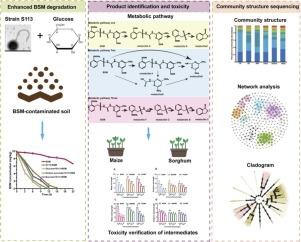Enhanced bioremediation of bensulfuron-methyl contaminated soil by Hansschlegelia zhihuaiae S113: metabolic pathways and bacterial community structure
IF 12.2
1区 环境科学与生态学
Q1 ENGINEERING, ENVIRONMENTAL
引用次数: 0
Abstract
Bensulfuron-methyl (BSM), a widely used herbicide, can persist in soil and damag sensitive crops. Microbial degradation, supplemented with exogenous additives, provides an effective strategy to enhance BSM breakdown. Hansschlegelia zhihuaiae S113 has been shown to efficiently degrade this sulfonylurea herbicide. However, depending solely on a single strain for degradation proves inefficient and unlikely to achieve ideal remediation in practical applications. This study assessed the impact of various carbon sources on the degradation efficiency of S113 in BSM-polluted soil. Among these, glucose was the most effective, achieving a 98.7% degradation rate after 9 d of inoculation. In addition, seven intermediates were detected during BSM degradation in soil through the cleavage of the phenyl ring ester bond, the pyrimidine rings, and urea bridge peptide bond, among other pathways. 2-amino-4,6-dimethoxy pyrimidine (ADMP), and 2-(aminosulfonylmethyl)-methyl benzoate(MSMB) were the primary intermediates. These metabolites were less toxic to maize, sorghum, and bacteria than the BSM. Community structure analysis indicated that variations in exogenous carbon sources and environmental pollutants significantly improved the ecological functions of soil microbial communities, enhancing pollutant degradation. Addition of carbon sources notably affected soil microbial community structure, modifying metabolic activities and interaction patterns. Specifically, glucose substantially increased the richness and diversity of soil bacterial communities. These findings offer valuable insights for field remediation practices and contributed to the development of more robuste soil pollution management strategies.

Hansschlegelia zhihuaiae S113 对苄嘧磺隆污染土壤的强化生物修复:代谢途径和细菌群落结构
苄嘧磺隆(BSM)是一种广泛使用的除草剂,可在土壤中存留并损害敏感作物。微生物降解,辅以外源添加剂,是加强苄嘧磺隆分解的有效策略。研究表明,Hansschlegelia zhihuaiae S113 能有效降解这种磺酰脲类除草剂。然而,在实际应用中,仅靠单一菌株降解证明效率低下,而且不太可能实现理想的修复效果。本研究评估了各种碳源对 S113 在 BSM 污染土壤中降解效率的影响。其中,葡萄糖最有效,接种 9 天后降解率达到 98.7%。此外,在土壤中降解 BSM 的过程中还检测到了 7 种中间产物,它们分别通过裂解苯环酯键、嘧啶环和脲桥肽键等途径降解。2-氨基-4,6-二甲氧基嘧啶(ADMP)和 2-(氨基磺酰基甲基)苯甲酸甲酯(MSMB)是主要的中间产物。这些代谢物对玉米、高粱和细菌的毒性低于 BSM。群落结构分析表明,外源碳源和环境污染物的变化显著改善了土壤微生物群落的生态功能,提高了污染物的降解能力。添加碳源明显影响了土壤微生物群落结构,改变了代谢活动和相互作用模式。特别是,葡萄糖大大增加了土壤细菌群落的丰富度和多样性。这些发现为实地修复实践提供了宝贵的启示,并有助于制定更稳健的土壤污染管理策略。
本文章由计算机程序翻译,如有差异,请以英文原文为准。
求助全文
约1分钟内获得全文
求助全文
来源期刊

Journal of Hazardous Materials
工程技术-工程:环境
CiteScore
25.40
自引率
5.90%
发文量
3059
审稿时长
58 days
期刊介绍:
The Journal of Hazardous Materials serves as a global platform for promoting cutting-edge research in the field of Environmental Science and Engineering. Our publication features a wide range of articles, including full-length research papers, review articles, and perspectives, with the aim of enhancing our understanding of the dangers and risks associated with various materials concerning public health and the environment. It is important to note that the term "environmental contaminants" refers specifically to substances that pose hazardous effects through contamination, while excluding those that do not have such impacts on the environment or human health. Moreover, we emphasize the distinction between wastes and hazardous materials in order to provide further clarity on the scope of the journal. We have a keen interest in exploring specific compounds and microbial agents that have adverse effects on the environment.
 求助内容:
求助内容: 应助结果提醒方式:
应助结果提醒方式:


